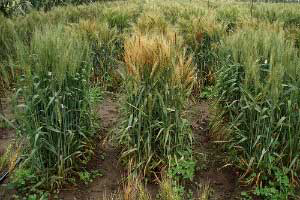Wheat head blight mycotoxins profiled for first time

A new study has profiled the mycotoxins associated with an outbreak of Fusarium head blight in Western Australian wheat for the first time.
Fusarium head blight (FHB) is one of the most devastating diseases worldwide for wheat crops, also infecting oats, triticale (wheat–rye hybrid) and rye.
It reduces grain yield and quality, but of more concern are the mycotoxins that can cause acute or chronic toxicity to livestock and humans. Moreover, FHB is very virulent, spreading rapidly throughout individual fields.
The study, a collaboration between University of WA, CSIRO Plant industry in Brisbane, and the Dept of Agriculture and Food WA, revealed the identity of the Fusarium pathogens from an isolated outbreak in south-western WA in 2003.
Using DNA sequencing, the study found that the main associated pathogens were most commonly F. graminearum, followed by F. acuminatum and F. tricinctum. Isolates were then subjected to brine shrimp bioassays to further determine the mycotoxin profile.
The main mycotoxins detected from the crude extracts; type B trichothecenes, enniatins, chlamydosporol and zearalenone, all caused high mortality to brine shrimp.
In Australia, FHB tends to occur sporadically in the wetter areas of Queensland and NSW. Outbreaks are relatively infrequent in WA, but the Fusarium spp associated with them can readily survive in stubbles, where they initiate further outbreaks once favourable conditions occur.
The study is likely to help other regions with similar Mediterranean climates and cropping practices, and is likely to become more relevant as a consequence of erratic rainfall patterns from climate change.











